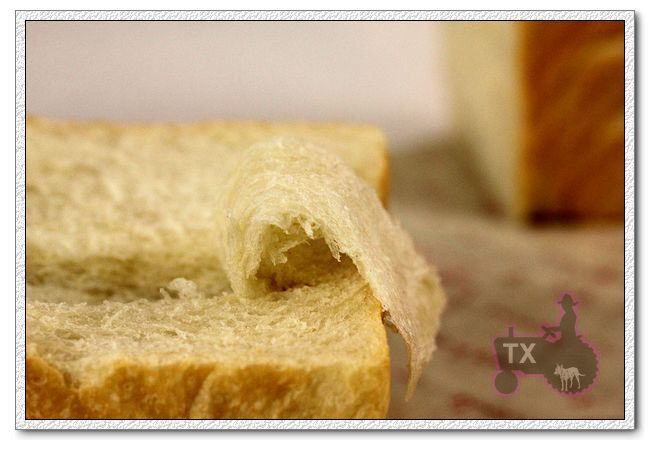
After posting about some soft Asian style breads, I have gotten more than a few private messages regarding how to make very soft sandwich loaves. I was a little suprised since my impression was that most TFL-ers here prefer a good crusty lean hearth loaf, and soft "wonder breads" are being looked down to. I guess there IS always a need for soft breads: elders and kids who don't have strong teeth, spreaded with a little jam for delicate tea sandwiches , or just because you like the taste and texture. Soft breads are not equal to tasteless wonder breads either, they can be flavorful, "bouncy", and full of body.
Pan de Mie is a slightly enriched bread, just like most soft sandwich breads. That little bit of sugar, butter (you can replace with oil), and milk powder (you can replace with milk, and take out water accordingly of course), only 5% each, are enough to make the crumb very soft. For even softer results, you can increase these ratios to 10% or even 15%, or/and add other enriching ingredients such as cream, cream cheese, buttermilk, cottage cheese, etc. However, adding too much, you are getting into broche territory though. This verion is raised purely with sourdough stater, but you can get good results using commercial yeast as long as the ingredient ratio is reasonable, and you do a good job at kneading/fermentation/shaping. However, since pan de mie has a very subtle taste, that bit of sourdough tang really enhance the flavor, I would highly recommend using it.
Sourdough Pan de Mie (my own)
Note: 19% of the flour is in levain
Note: total hydration is 65%
Note: total flour is 280g, fit a 8X4 loaf pan. For my Chinese small-ish pullman pan, I used 260g total flour. For KAF 13X4X4 pullman pan, I would suggest using about 450g of total flour.
- levain
starter (100%), 15g
milk, 24g
bread flour, 46g
1. Mix and let fermentation at room temp (73F) for 12 hours.
- final dough
bread flour, 227g (I used half KAF bread flour and half KAF AP flour for a balance of chewiness and volume)
sugar, 14g
butter, 14g, softened
milk powder, 14g
salt, 5g
water, 150g
2. Mix together levain, flour, milk powdr, sugar, and water, autolyse for 30min. Add salt, mix until gluten is developed, add softened butter, and knead until the gluten is very developed. This intensive kneading s the key to a soft crumb, and proper volume. We've all heard of windowpane test, but what's important is how STRONG the said "windowpane" is, which is a measurement of how strong the dough is, and how uniformed the gluten structure is. The following the a picture of my windowpane test on this dough, notice that it's thin, but so strong that it doesn't tear even when I wear it as a glove and my finger is poking at it.

When I finally poke through, the edge of the hole needs to be very smooth.

Yes, it can be done by hand. I have regularly kneaded dough to this stage by hand, it just requires a bit of patience and practice. Of course it's easier with a mixer. In my KA pro6, this dough took 13 to 15 min of mixing at speed 3 or 4 (I know, I know, it violates the KA mixer manual. If you are worried, don't do it, just mix at speed 2, it will take (quite a bit) longer. I have been using this "illegal" method for 2 years now, the mixer has not complained.), doughs with more fat would take longer, different dough size would also affect the time. Do note that it's very possible to over-knead, especially with a mixer, even a couple more minutes after the stage above, the dough would deterioate quickly, it takes a few trial and error to get it perfect. I would suggest to touch and feel the dough every few minutes even you do use a mixer, so you get a good sense of how the dough changes. This intensive kneading technique is quite useful, not just for soft sandwiches, but also for brioche, or other enriched breads. However, for lean hearth loaves, I don't knead at all, I stretch and fold, to get the open crumb. I think different breads demands different techinques.
3. Bulk rise at room temp (73F) for 2 hours, the dough would have expanded noticably, but not too much. Fold, and put in fridge overnight. I find the crumb would be more even and soft if dough gets a full bulk rise - that is true even when I use dry yeast with this dough.
4. Divid, rest for one hour, then Shape into sandwich loaves, the goal here is to get rid of all air bubles in the dough, and shape them very tightly and uniformly, this way the crumb of final breads would be even and velvety, with no unsightly holes.
For the 8X4loaf pan, I first roll out the dough into pretty thin, getting rid of bubbles in the mean time. Fold two sides to middle (see picture below), then roll up like a jelly roll, and put in the pan seam side down.

However, I much prefer the pullman pan method. First divide the dough into 3 or 4 pieces depending on pan size, roll each piece into oval, and roll up. After resting for 10min, roll out each piece into long oval again(along the seam), and roll up again, tighter than the first time. Put the pieces seam side down in the pan. By rolling twice, the crumb will be more even and "pore-less".




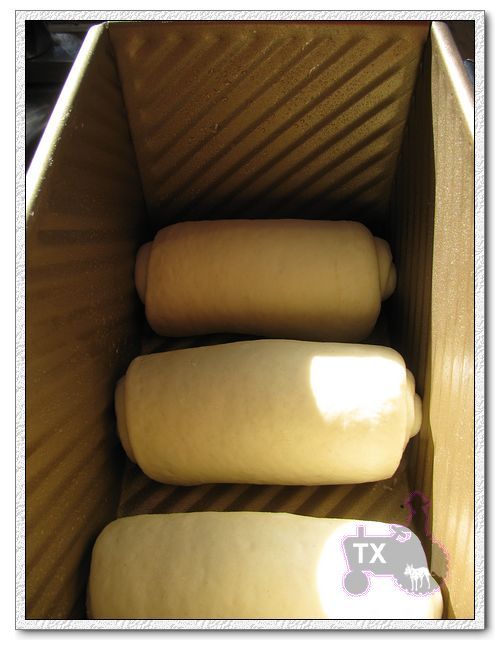
5. Cover and rise for about 6 hours at 73F. For pullman pan, the dough should be 70%full

For 8X4loaf pan, the dough should be about one inch over the edge

6. Bake at 375 for 45min. Immediately take the bread out of pans, and cool.
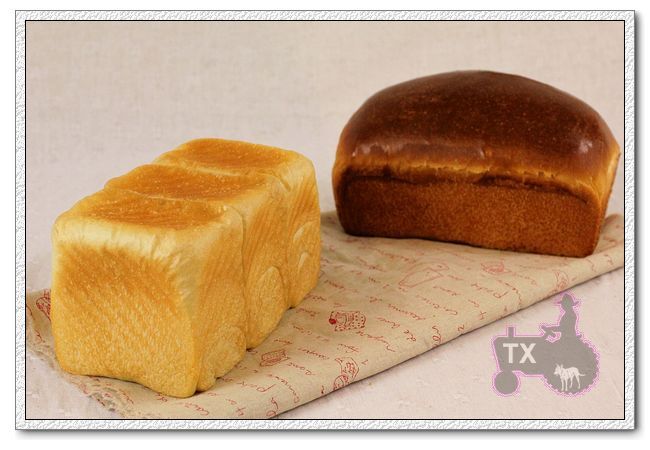
Looking at the crumb shots below, you can see the difference between two shaping methods, the "double roll" really make the crumb more even and pore-less:
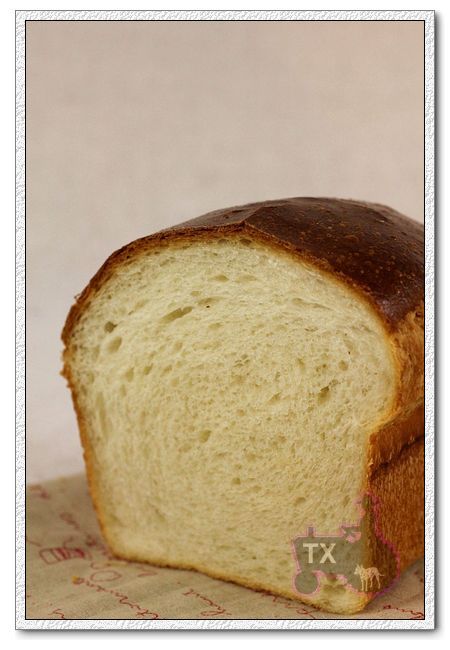
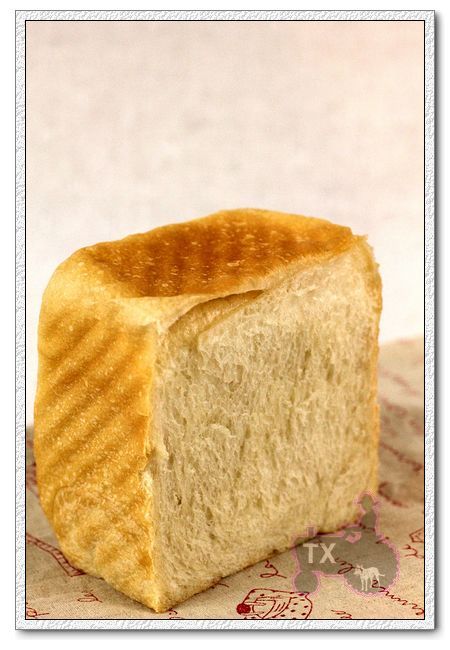
Of course, the "pore-less" crumb is more about aesthetic, with either shaping method, the bread would be shreddably soft.
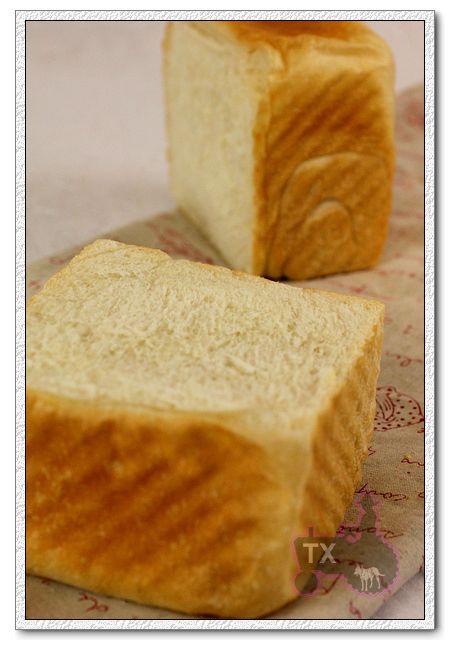
Makes a great grilled cheese:
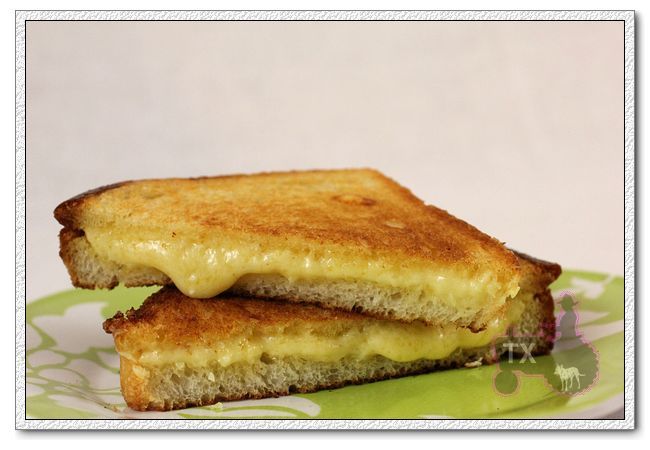
Or as I tend to do, just tear pieces off and snack on
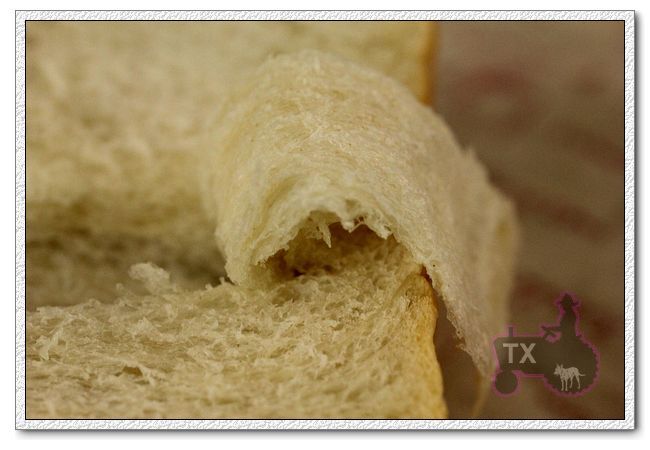
Sending this to Yeastspotting.
- txfarmer's Blog
- Log in or register to post comments
Hi TX Farmer
A very nice write up and very nice looking breads, there certainly is a place for the enriched and the more straight forward types of bread and you have demostrated very successfully that sour dough doesn't always need to be big open holes. I often see see new members trying some of the more complex breads or methods and becoming disheartened that they are not achieving the same sorts of success straight up.
Having done an apprenticeship and worked in bakeries the aim was to produce breads that were fine textured with a tight even crumb and to have large holes was viewed as poor workmanship.
I do enjoy making my sourdoughs now, but certainly didn't find them easy to master and even now am still trying different things that i have picked up along the way from forums such as this.
I do feel that some of our new to bread making members would benefit from trying some of the more straight forward conventionaly fermented doughs which can be either short or long duration. A bit of walking before you run i guess and of course nothing breeds success like success. Thankyou for your post and sharing
regards Yozza
I actually don't think these soft tight-crumbed breads are "easier" than the hole-y ones, they are just different, and requires totally different skill set. The intensive kneading for soft breads can be hard to get right, but you are right, this style of breads is closer to "traditional" method, which means more people would be familiar with the concept. While the lean loaves requiring S&F, long fermentation, and iron hand velvet glove shaping are a bit more "artisan", may be hard to grasp at first.
Hi txfarmer i tried your shreddibly soft sourdough loaf and failed miserably i dont know if it was the way i kneaded it if i did to much or if its because my sourdough starter didnt like it, because there wasnt any rye or whole wheat. The dough took hours to rise and was very dense and was slightly chewy, it was everything but light and fluffy. I was disapointed because i would like a sourdough recipe for a soft sandwhich loaf.
I have a 13x4x4 Pullman bread pan and I see you suggest using 450g flour.
Does the Levain amount stay the same even though the flour is upped from 260g for the smaller batch to 450g? Or is the Levain changed to almost double?
I hope you still read replies on this thread, as it is 10/25/2018.
Thanks Shaley
But I feel you have to scale everything up. So change it all, including levain. I think you have to multiply by 1.6 or 1.7. I did the calculations elsewhere and it's something like that.
Good luck
hester
Very nicely done TX. The loaves look delicious and the pictures are so graceful! Those loaves scream PB AND J!
I am having a bit of a hard time grasping the double roll method. Are you; dividing the desired dough into three equal size portions. Rolling them out flat, rolling them up. Resting, then repeating the same procedure? Sorry its a bit late for me but I am waiting to register for class and thought I'd hop on the best place on the web!
And is your smaller pullman pan a 9x4x4?
I have added more pictures to show the process of double rolling, hope it's more clear now .
My smaller pullman pan is from China, which is of totally different/odd size, but as I have noted in the formula, for a 13X4X4 pullman loaf (which I have and used before), 450g of total flour would be right.
This will be very good for my father who regularly complains about my crusty bread.
If i want to take it to poor man's brioche level, could i just increase the butter ratio to say 20% of flour weight and proceed in the same way, but kneading longer i suppose. Also could i replace all 20% of the butter with oil?
you must have heard of/tried the 'tang zhong' method using a sort of water roux, how does this compare in your opinion?
finally, if i'm less keen on the tight pores and prefer a looser crumb, does that mean i should simply roll less tightly?
thanks once again!
- Yes, you can use more butter/oil as you like, however, natural starter does slow down when fat content gets above certain level. I have tried using 15% butter, along with egg and milk with no obvious slow down, but at 20% butter, the final rise would take noticably longer. Yes, you can replace with oil.
- I have used "tang zhong" method, even bought the book and made most recipes from it. It was at the begining of my bread baking journey. At first I found it really useful - breads were softer and stayed moist longer. However as my basic techniques (kneading, fermentation, shaping as described in the post) improved, I found that it's really not necessary. I can get a very soft and velvety texture without "tang zhong", even without too much of other enriching ingredients such as mashed potato, yogurt, etc etc. All you need is a little bit of butter/oil, a bit of sugar, and good techniques. With sourdough, breads stay fresh longer anyway, so I really don't need "tang zhong" now. In summary, "tang zhong" is merely an extra tool, what I posted is good basic techniques. It's enough if you do the basics well, you don't need other tools, but you can still add "tang zhong" to your well kneaded, wel fermented, and well shaped breads, it won't hurt.
- yeah, rolling once will give you a looser crumb, however I do suggest you to try both methods. Tighter crumb offers a special texture - makes the bread soft, yet you still have something to sink your teeth into, a little extra "bounce".
Interesting idea! I never thought of using sourdough starter to make super soft bread before.
Thanks for sharing the recipe and detailed instructions. I will try this when I visit my family in Thailand...as they would prefer super soft bread over crusty ones.
Sue
http://youcandoitathome.blogspot.com/
Soudough starter is merely a way to raise breads, any kind of breads. Both my husband and I were blah about enriched breads before, until we used sourdough, the extra tang really enhance them.
Let's not forget that breads using sourdough starter and with at least 6 hours fermentation is much healthier than other breads. I won't get into the specifics as to why because it is easy to do a web search on the subject.
This is why I am so excited about your recipe!
I have enjoyed the Tangzhong Milk Bread but recently have been focusing on better nutrition using sourdough. I thought this meant not getting that really soft texture bread I like from time to time. But you have just made my day!!!
Thanks for sharing.
Hi txfarmer,
your conventionally-made breads show the same dedication to detail and care in the process as your "artisan" breads; very lovely to behold.
I agree with what both you and yozzause have to say about the skills set needed for both types of breads referenced.
Derek may well be familiar with the concept I've entitled to this thread post? Although, your photos detail what would be called "three-piecing", I guess. Anyway, your observation about the crumb structure being better using this method is quite correct...and this is why:
A single moulded piece results in gas bubbles which run up and down the loaf. Given the four pieces are turned on their sides, these gas bubbles now run across the dough from side to side. I'm no physicist, I'm afraid, but the way the light reflects off the finished crumb is superior in the "four-piecing" method than it is in the single-piece moulding.
Nearly all of the UK plant bread is made using "four piecing". Sadly, that does not help to make it anywhere near as interesting, or, lovely, as the loaves you showcase here!
All good wishes
Andy
I can always count on learning expert knowledge from you. For my 4X4X13 pullman pan, I usually do a real deal "four-piecing", but this Chinese pan is a bit small (finished loaf is 1lb), so 3-piecing instead. What you said about gas bubbles run side to side makes sense to me. I agree that if well made, ANY type of bread can be good, and each presents its own challenge to be perfected.
Thanks for sharing! I was looking for the kind of loaf that would be good to practice my kneading on. I think I just found it :-)
I'm looking forward to tasting the sourdough in it, great idea!
Thanks!
than comparing single to double rolling. Both loaves have a grain that runs through them caused by the shaping of rolling up the dough. The pullman loaf has the grain running across the short width of the pan (3 times) the domed single has the grain running the length of the pan. So in the pull man loaf, the bread is not cut across the grain which is the main difference in looking at the crumb shots. (If it helps, think of cutting a large onion. Cutting across or from the ends would give two very different looks to the same onion.)
I can't really compare pores between the two because the cuts are different. Funny, don't ever remember discussion on crumb shots before but most crumb shots show cuts that run across the grain. (exception cinnamon rolls) So unless the pullman is cut against the grain or the singled rolled loaf is cut lengthwise, I can't really compare crumb pores.
I can compare the cuts and have to agree that the pullman presents the crumb differently. Very much like we pull apart croissants or cinnamon rolls to show fluffiness.
How the bread is eaten has a lot to do with which crumb we are trying to achieve when we bite into the bread. Why is the "asian style" bread softer? I think much has to do with biting against the grain vs with the grain. A bread that flattens faster under pressure is perceived as soft. So some added softness can be achieved by simply changing the direction of the grain in the loaf. Changing the physics involved. Interesting....
Against the grain vs. with the grain would indeed presesnt the texture differently! Sort of like when we cut steak or other pieces of meat. Hmmm, can't believe I missed that important point. Thanks mini, you always give me food for thought!
I am working to perfect TX’s SD Sandwich Bread. Your post from over 11 years ago is enlightening. Your mind is so open, and your statements force me out of my box…
”Both loaves have a grain that runs through them caused by the shaping of rolling up the dough. The pullman loaf has the grain running across the short width of the pan (3 times) the domed single has the grain running the length of the pan. So in the pull man loaf, the bread is not cut across the grain which is the main difference in looking at the crumb shots. (If it helps, think of cutting a large onion. Cutting across or from the ends would give two very different looks to the same onion.)”
The onion example is perfect, THANKS!
Danny
Though we are also great crust fans, my half-Venetian husband would love to make as good Tramezzini at home, as he had them in Venice. And so far our trials to come up with the right kind of bread (Pan Carre) have not been very successful. But your Pan de Mie - the lighter one - looks just like it.
As usual, you showed us great results!
Thanks, txfarmer,
Karin
I had to google to find out what Tramezzini is, it looks delicious! From what I read, the sandwich is made with crustless white bread, so yes, pan de mie baked in pullman tins would be perfect for it!
Hi TX Farmer
With the sandwhich bread does your pullman loaf tin come with a lid or have you turned the tin upside down to bake?
Regards Yozza
It comes with a lid, most pullman pan does.
1) starter == 50% water + 50% flour + some amount of natural yeast which you would replace with instant dry yeast, when i say total flour, it already include flour in the starter, so you just need to add the water in the starter, the extra water in the levain to the main dough, then scale everything to 450 from 280. In this case total liquid would be 253g of water and 39g of milk. You other calculation seems to be right.
2) when you use instant yeast, the fermentation time would be much shorter than sourdough, no matter whether you scale my recipe or KAF's. If you use 1% yeast, the first rise would be around 2 hours, the 2nd rise would be around 45 to 60min, at 20 to 25C. It would be even shorter if you use more yeast, which I don't recommend - longer rise == better flavor. Don't watch the clock, watch the dough, you can judge whether the rise is done by looking at how much the dough has expanded, or better, by press it lightly and see how much and how fast it bounces back.
Txfarmer, I'm a great fan of this kind of breads, but I have a doubt.
You used bread flour that is quite high in gluten (and it shows perfectly well from the picture), but how to proceed with weak flours such as durum wheat or even white spelt? Contrary to bread flours it's very easy overkneading them: they have virtually no resistence and a very weak gluten. Every time I knead doughs with those flours I can't get past 5 minutes because they tend to literally dissolve.
Can you advise me how to proceed? Thanks.
The high gluten flour here provides volume, the more low gluten flour you add, the less volume you will get with the same amount of flour. So you need to either add more flour or be OK with a smaller bread.
I usually mix weak flour with bread flour, rather than use weak flour only. The more weak flour you use, obviously you need to knead "less", because the gluten network (window pane) won't be as strong, which is why the bread volume would suffer unless you add vital gluten.
However, I have done 100% whole wheat breads with similar techinique, the kneading process is similar, the windowpane is a tad weaker, a bit quicker to achieve, and I use some more flour for the same pan, but the end result is still very soft and full.
Thank you, txfarmer, for your description and photos of a strong gluten. I have failed in the past to get more than a weak window pane test; but thought it was sufficient.
Your article was soon followed by the arrival of my spanking new Electrolux Assistent. I used your recipe, modified a bit, and scaled up for a 2lb loaf pan. I kneaded at a medium high speed (sixth of eight speed indicators) with the roller and flipper. The dough passed your "glove" test in about 12 minutes, including several stops for testing.
The bread was, indeed, shredably soft with a delicious balance between sweet and sour.
It is painfully obviously that I hadn't been kneading nearly enough for a really good sandwich loaf. Since sandwich loaves are my principal home bread, I expect a considerable up-tick on the satisfaction meter.
Again, thank you,
gary
Thanks for the feedback, I am so happy that you got the loaf you wanted! :)
Here in Asia this is the normal bread. The softer the better. I am in the process of writing down my recipes for my children and have include one which use the TZ roux. From time to time I send the recipes to my daughters to make and test.
She made the TZ bread and to her horrow found it so delicious that she ate nearly the entire loaf. This is the danger of the "soft bread". She wishes that I had not told her of it and vows not to make it again.
We strictly make artisan type breads and our customers are in the main expats looking for European Bread. They cannot stand the local "soft" bread.
The local people complain that they can only eat one or two slices of my bread, but the entire loaf of the local "soft" bread. They tell me that there is something wrong with my bread.
So be careful of liking the soft bread too much, it seriously damages the waistline.
regards
Has anyone converted this recipe to cups/tablespoon type measure.....I am just so bad at the conversions. I tried and I'm so confused.....
Hi Ruthie,
In all honesty, of course any recipe in weights can be converted, but here's the main problem: you end up with way too many instances of 1 Tbsp + a scant 1/2 tsp., etc. Almost every converted dry ingredient includes 'scant' or 'heaping' to be accurate, and then how accurate can that really be? Don't even get me started if there's things like eggs... While it might be fun struggling through all of that once, doing that every time you want to make that recipe would get tiresome. Getting a digital kitchen scale would be the actual easiest solution. They are extremely cheap compared to years ago, and it will change your baking forever. Your measuring cups and spoons will call you vile names every time you come into the kitchen. You just have to learn to ignore them. ; )
If you insist, though, use Google to find a few sites that will help you convert. I had a list of 2 or 3 in my favorites years ago, but have since lost them, as I stopped using them. I'm sure they are still there, though. Once you get the hang of it using a website to help you, it gets fairly easy, but measuring out all of those scants and heapings never gets easier.
- Keith
Thank you Keith for going to the trouble of answering me. I do have a scale and did use a gram converter as well but I was still confused about the amounts of flour, I think it was ...or maybe it was the starter but none the less, I have a scale but was still having issues.
Are you saying that your scale only does ounces, and you need the conversion from grams?
I'm kind of confused where you're hung up... you asked if anyone had converted to cups/tablespoons, but you say you have a scale.
Are you having an ingredient(s) misunderstanding, or is the fact that there's one phase using flour (the levain) and then there's more flour to be added to the final dough?
- Keith
Thanks for your concern, someone else has helped me. Ruth
Txfarmer, I made this bread once more. Here are the pictures
http://www.cookaround.com/yabbse1/showthread.php?t=223973&p=4876932#post4876932
I'm very satisfied, but I guess there are margins for improvement. What do you think?
Thanks,
Nico
Looks great!
Thanks for this recipe txfarmer, I love it. Since Wonder / Hostess went out of business, I have been looking for a good soft loaf for toast to make breakfast or BLTs and Tuna sandwiches. I haven't bought a loaf of bread since they closed thanks to this site =)
The first time I made this loaf, I wasn't following the instructions very well and used a 9x5, it didn't even reach the top of the pan but it was still delicious and soft.
I made the 8x4 loaf, but my little loafpan is probably more like 7.5 x 3.5.
I didn't retard during bulk rise or proofing, this was a room temp bulk rise at 74 degrees F for 2.5 hrs. Then shape and proof for 4 hours. The flavor was very mildly sour and it was the most adorable little loaf! I might bump up the amount next time to make a full size loaf.
It made the kitchen smell irresistible!
Nice even soft crumb
Hubby says it's the best toast he's ever tasted!
This recipe will be one of my favorites for years to come! Thanks again!
I'd love the complete conversion for this to fit the 13x4x4 pullman pan. I have a scale...just not great and maybe lazy on the math skills! :)
I had some trouble with the levain. After leaving it for 12 hours (in the oven with the light on because it's cold here) it didn't have a single bubble. Is this what is supposed to happen? I left it on the bench for another 12 hours and it did produce bubbles then, but it was too late to use it by then.
I know this is an old post, but I finally made this today using my 13x4x4 pullman pan. I was going to change the procedure a bit, but decided to follow the directions since this was my first time with this recipe. I found that the texture was very soft like I wanted. The flavor was a little sour for my taste. It was more of a sour from the milk (or milk powder) than the acetic acid type of sour. It is hard to describe. Now it is possible that this will mellow (or transform) tomorrow. I did toast some up and that changed things a bit (good toasted with butter and good toasted with jam). I preferred it toasted to plain. I didn't try it plain with any additions, so it might be fine as a sandwich or with butter/jam, etc.
One problem I had was that at a 70-75% rise it wasn't enough to reach the top of my pan. So either I needed it to go longer (like up to 1/2 inch below the top instead of 1 inch) or I need more dough (I used the suggested 450g total flour). So next time I will let it rise more.
The other thing is that I might try it without the refrigeration. If I mix up the levain the night before, then it could be done in one day. I am debating whether or not to just forego the levain build and just use straight starter and adjust accordingly (still using the 19% pre-ferment flour).
Lastly, since the dough never touched the top, it did not brown. Next time I will remove the lid part way through like I normally do. Also, I think 45 minutes is too long for my oven. The internal temperature was higher than I would normally go for a pain de mie.
Mixing in the butter is always an issue for me. I never seem to time it right so it makes the incorporation of the butter more difficult. Next time I will either add it a little earlier or let the dough rest first (probably the former).
So in general, I really like this one. It is definitely a light and airy bread. I think that it has a lot going for it and some might like the extra sour. I normally like sour in my bread, but this was different. Perhaps it was just too much for my pallet (or it will change over time). I was very pleased that this came from my starter as I have only done commercial yeast pain de mie in the past.
Okay, so the next day this had a different flavor. It was less milky sour and more like my starter tastes when it peaks (yes I taste my starter). I think this might be too sour for many people but makes me curious about applying some of this technique to my lean sourdough bread.
has anyone tried this successfully using freshly ground whole wheat? I've been trying to come by a recipe that my boughten bread loving husband will eat for his sandwiches and such
Used my white 100% levain, followed instructions and came out beautifully. This my first trial on this recipe. Many to follow for a white sourdough sandwich loaf. Very resilient. I had to leave for a bunch of hour right around when the bulk rise was almost done. I threw it in the freezer figuring all might be lost. I pulled it out of the freezer (frozen solid) about 6 hours later and let it sit on the counter till morning. The put it in the fridge to thaw the rest of the way, then back out on the counter to watch it finish the bulk rise. Seperated rolled out to the pullman style then baked per instructions came out beautifully. A winner - going to stay in my go to for a white sandwich loaf. Thanks!!
Well the trial loaf was a big hit with my whole family. One asked if it was "potato bread" :-) 5 us had it for breakfast toast, then for grilled cheese & tomato. Before that a few slices were used for sandwiches. Interesting this is that this loaf was thin sliced, separated into 2 packages and vac sealed after totally cooled and wrapped for a good long while. We had a lot going on. Those two packages were then vac sealed and placed in the fridge. I ate the two heals a couple days after the cook (toasted).
So to me this speak to resilience. My daughter and grandkids liked it so much - texture and the sourdough flavor that I'm starting a double batch/2 loaves today. Levain is relaxing on the counter, everything else measured out.
Have to note that the levain ratios for me anyway resulted in a very very dry mix, I added just a bit more milk while mixing until it all would incorporate. Careful not to add too much, just so no dry powder was left in the bowl.
Last time I added a "cheater" couple grams by eye of IDY. I'm going to ride the same way this time. After this I'll try without the crutch. But will add the same amount of IDY for the double batch as I did for the single recipe.
I'm going to try kneading the double batch on the 4/5 setting as previous. If I throw an internal motor breaker I'll divide and conquer. It's a long rise so wait time to split between two mixing bowls and reset shouldn't cause a problem.
I did notice some heat build up on the motor cavity during the previous run, but wasn't all that serious.
My second with 2 loaves worked great. I used two pullman pans. I separated the dough in two after the bulk rise in the fridge. Then broke each round into six rolls into each pan. Rise for 8 hours worked great. Baked it last night had some today. Nice square loaves with a nice thin crust.
This is a keeper recipe for me at this point.
The cool think is I use my starter and the sourdough flavor is excellent. The crumb is great for sandwiches, french toast, etc. Or just plain eating. I have one of the loaves in the freezer/vac sealed. Let's see how it holds up.
Go to pullman/sandwich loaf for me moving forward.
Hello txfarmer and other tfl members. I believe this is my first Comment. Anyway, i am new to sourdough baking. I started my starter about 4-5months ago? ive had a few successes and felt enough confidence to tackle this bread. I did pretty good, I think! Of course it wouldn't have been possible without txfarmers wonderful post and recipe, as well as everyone elses knowledge on this site . I made a couple mistakes and fumbled a bit. But i am quite pleased. i believe my boys, who will be eating th majority of the bread, will be extremely pleased as welL. My eldest, the diplomat, says he loves my holey bread- but he really loves the square breads. lol my next endeavor is the sourdough hokkaido milk loaf. Then the ww one. Of course I'll be sticking with txfarmers recipes for these. Thank you again!
Hi Tx
Could you elaborate on this part
Note: 19% of the flour is in levainNote: total hydration is 65% levain starter (100%), 15g milk, 24g, bread flour 46g ? I'm a new learner in baking. Appreciated your advice TQHi txfarmer - I know this is a very old thread, but I'd like to try this recipe. Is there any way to update the photos? I'm sure they would be very helpful here.
Thanks!
yes please can you update the photos! I'd be so grateful!
This is the best I could reconstruct:
https://drive.google.com/open?id=16dXKPCASpHlT2dBZEG1hgsqgS45LokgK
This is the best I could reconstruct:
https://drive.google.com/open?id=16dXKPCASpHlT2dBZEG1hgsqgS45LokgK
This is the best I could reconstruct:
https://drive.google.com/open?id=16dXKPCASpHlT2dBZEG1hgsqgS45LokgK
Hi!
I also cannot access the photos. Is there any way you could make them available please? I'd love to try the bread and just like emott I believe the photos would be very helpful!
Thank you!
This is the best I could reconstruct:
https://drive.google.com/open?id=16dXKPCASpHlT2dBZEG1hgsqgS45LokgK
Does the ratio of levain (according to your recipe and recommendation) change when the ratio of flour is changed for the Pullman 13x4x4 pan from 260g to 450g?
Thanks Shaley
Thanks so much for making your recipe and pictures available. I have been searching for sourdough white bread for months, ever since a local bakery changed the recipe. Didn't manage to find a suitable replacement so decided to bake it myself. After a whole bunch of reading (including your website), purchasing a kegerator and temperature controller (to control the temperature of the fermentation) and some starter powder, I boldly ventured into sourdough baking.
For my first attempt I used 167 gram of starter and a total of 551 g of flour for a 13x4x4 pullman pan. The bread turned out quite good but not nearly sour enough for my families taste buds.
For my second attempt I upped the starter amount to 367 g and the total flour to 676 g. I also used whole wheat flour for the starter and increased the milk powder by 33%. I ended up using 6 of the little "jelly rolls" of dough for the larger pan. This filled the pullman loaf pan a bit better and results in the perfect amount of tang in a soft but dense bread!
Impressive!
Mini
i have been looking for a sourdough Pullman loaf recipe, and this looks likely. Are the milk powder and sugar necessary? I have starter ready to go, and am not looking for a sweet loaf at all. My pan is 13” so I’m guessing I should use about 450g of Lourdes since the starter/leaving is ready? Hope you’re still responding to questions!
Thank you!
Sorry about typos! Lourdes? Should have been flour. Leaving, of course, should have been levain. Spellcheck gone rogue.
I have made this twice now for my 9 inch Pullman pan and the texture is amazing. It didn’t fill the entire pan either time, though, and I allowed it to rise as much as it was going to rise (well past six hours). It gets pretty close though, and the texture is pretty perfect. Any idea what is going wrong? My starter is pretty robust. I could just add like a tenth more of everything and just be done with it, but I sort of want to do it “right” if this is actually rising to the top of everyone’s pan except mine!
I made this a few days ago and it turned out beautifully, even with hand kneading. Super soft and shreddable. Anyone knows how to adjust the recipe if using fresh milk instead of powder? And does anyone know how to incorporate oat porridge in this kind of bread? Thank you!
Looks so yummy. But if you’re going to use French to name your recipe, please spell it properly. It’s Pain de mie. Pain in French means "bread", and "la mie" refers to the soft part of bread, called the crumb.
Hi! thank you so much for posting this. Even years later people like me are finding it useful! I'm trying to make a sourdough challah and the texture isn't right. What I've learned is that I am no where near close to kneading it enough. Going to try the challah again! I'll copy your bulk, divide, rest, shape, and proofing timings as well to see if that helps.